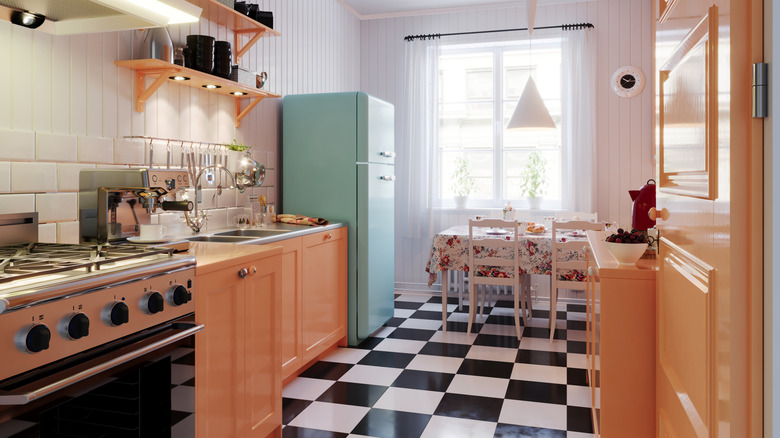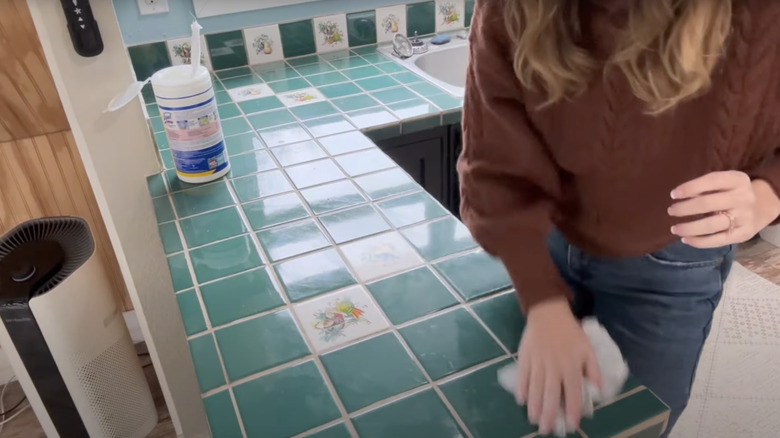'80s Kids Will Totally Recognize These Kitchen Countertops
The 1980s was a decade of distinctive styles. Parachute pants, acid-washed denim, bangle bracelets, and high-top sneakers were all the rage in the fashion world. In the design realm, features like glass block walls and wallpaper borders were everywhere. In circa-'80s kitchens, one pervasive feature that countless homes had was the tile countertop.
You know you were from the '80s if your childhood home had culinary surfaces covered with little ceramic squares — surfaces that seemed more at home in a bathroom shower than beneath your morning cereal bowl. You may have even enjoyed an old-school, no-longer-popular TV dinner atop a tiled kitchen island or breakfast bar. But, like those certain flavors of microwaveable meals, tile countertops went away for a reason.
While certain attributes made the surfaces popular for a time, they had distinct drawbacks that drove them out of fashion. Nowadays, if you try selling a home with tiled counters, you'll find it's not a feature that realtors will cite as an asset in a listing. Surfaces like quartz and marble are excellent for resale value, but tile definitely isn't.
The advent of tile counters
Tiled counters took hold as a popular option for a few key reasons. For one, they were incredibly affordable: It was much cheaper and easier to install tile than other surface materials like stone. A handy homeowner could even DIY the job, saving the expense of a contractor. The material's heat-resistant nature was another major attraction, as hot dishes and pans could be placed directly on it — though this always came with the risk of discoloration and thermal shock damage.
Tile also fit with the varied design trends of the time, which ranged from busy geometric patterns and bold colors — neons and primary colors figured big on the '80s palette — to subtler pastels and floral designs. The variety of hues and patterns available in tile form was virtually endless and could be adapted to any design scheme, from the more bold and vibrant to the more subdued.
Some say the motley tastes and haphazard creativity of the age helped spur the advent of trends like tiled countertops. The '80s was a decade of contradictions and rule-breaking, like using outdoor furniture in living rooms or bedroom mattresses filled with water. It's easy to imagine someone in the process of tiling their kitchen backsplash suddenly thinking, "Hm, I wonder what would happen if I put this extra wall tile on my countertop?" And, boom, a trend was born.
Tile falls out of favor
Though tile countertops were a budget-friendly option, they certainly weren't a perfect one. They were also by no means low maintenance, requiring extra cleaning and upkeep to keep them looking presentable.
One issue inherent with having tile on food prep and eating surfaces was the grout, which was difficult to keep clean and a hotbed for bacteria. Being in a constant food splash zone quickly led to unsightly grout, as it's prone to staining even with stringent cleanup practices. Regular sealing can help combat this, but that's just more maintenance to further lessen the appeal of the product.
Tile is also prone to breaking and chipping. One heavy pot or cast iron pan dropped on a tile counter can leave it cracked and unsightly. The surface also isn't smooth and unified like natural stone or the laminate countertops every kitchen in the '70s seemed to have. The repetitive transition from tile to grout creates a bumpy, uneven work area that is comparable to driving on a cobblestone road — you can certainly reach your destination on it, but it's a much rougher ride.
Of course, styles seem to be ever on repeat, and tile countertops are no exception. Like many retro kitchen design fads, they are a trend that's coming back around. It just goes to show that no style movement is ever truly dead. If you're tempted to give tile counters a try in your own kitchen, keep in mind that the same problems that plagued tile countertops in the past are still factors to contend with today.



